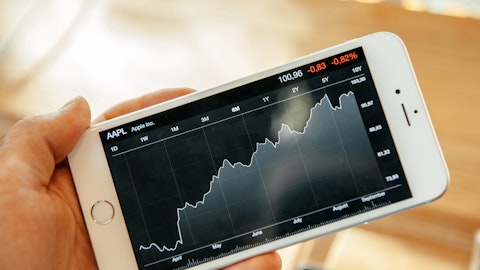So, overall, I think FY ‘25 is in really good shape.
Ruplu Bhattacharya: Okay. Thanks for all the details.
Kenny Wilson: Thanks, Ruplu.
Operator: Thank you. Next question is coming from Steven Fox from Fox Advisors. Your line is now live.
Steven Fox: Hi. Good morning. I just wanted to follow-up on some of the comments you just made on the revenues and how it’s playing out by the different served markets. So, you mentioned that new program costs are down, so I guess you’re seeing pushouts in certain markets. But then you also mentioned that customer forecasts are coming down, which I assume is for existing programs mainly. So, I was wondering if you could sort of dissect not every single line item, but just sort of big picture where you’re seeing more new program pushouts and why and where it’s more related to current end demand? And then I had a follow-up.
Kenny Wilson: Yes. Thanks, Steve. So, I would say, I mean, if we — if I run through our end markets, just to give you some color, so 5G is obviously soft, and you see that from the customers that we serve. A slowdown in end markets there and our network and switching business, we see the kind of campus and enterprise space, softer with an inventory glut, but we’re really going great guns and accelerated switching around the AI space. So, that’s been pretty positive for us. In healthcare, ortho is down, but pharma and med devices are up. And then in auto, which I think is a part — in terms of your question about new products, we see the new products getting pushed out there to some degree. What I would always say is that or what we’ve always said is that, look, we think our auto business is going to be up into the right, but it’s not going to be linear, it’s going to be lumpy.
And we see that. And if you look at the auto market, where people are saying that the expectation is that it’s going to grow 20%, 30%, but you look at the inventory in the lots right now. So, we see some push out in automotive. Although to Mike’s earlier point, we’re still growing pretty nicely there. And then, on renewables, so we look at, kind of, residential slowing down with interest rates, effectively commercial still going reasonably okay. We see a kind of slowdown in energy storage as people wait for the IRA to really get bedded in. But we think the backlog here is going to recover relatively quickly thereafter. So, I think — I mean, that’s some of the key end markets I mentioned in cloud, where AI is really driving our cloud business.
We’re operating in a new facility to support that. So, we’re up there. And so, generally, renewables is a little bit softer with some new product being delayed. We do see consolidation in the renewable space, which I think is going to help us for sure as the industry recovers there. And then — and automotive is just a push out of some orders, but — so hopefully that answers your question.
Mike Dastoor: And if I could just add, if you look at EVs, I think, everyone has seen the choppiness, everyone has seen the increased inventories at dealers, et cetera. I think the early adapters have already played out and they’ve got their EVs. It now becomes a question of cost. All the OEMs, all the EV companies are going to try and get their cost down. Who do you go to when you want to get your cost down? To an EMS company. So, this value proposition that EMS provides from an EV manufacturing perspective, we’re well positioned for EVs, we’re well positioned for hybrids. If you look at the battery management systems, the compute modules, the optics, all of that, we’re in a good space to actually provide some value to OEMs who have to now take their costs down a bit, because that’s the second wave of EV will be cost based, not the early adoption wave that we just rode a few quarters ago.
Steven Fox: Great. That’s very helpful. And then just as a follow up, Mike, I know you’re still saying $1 billion plus for free cash flow, but off of the November announcement, if I just changed the revenue assumptions and kept my working capital turn numbers, the lower sales was like worth $200 million more of free cash flow by my calculation. Is that the type of sort of change in free cash flow we can see off of the revised guidance, or am I missing something?
Mike Dastoor: So, obviously, part of free cash flow is income, Steve. And when you lose $2.5 billion, you do lose income. Even though your margin is maintained, the dollars do come out. So, there is an offset. You’re absolutely right on the working capital. Working capital does go down, and that is sort of baked in, but you also lose the income. The other area that we’re looking at is CapEx very carefully. We’ve always been disciplined. In these times, we’re even more disciplined and if we’re pushing out investments, we’re pushing out some level of CapEx that would help free cash flow as well. And it’s early days, Steve. That’s why we’ve stuck with the $1 billion plus. But do I expect it to be higher than that? Yes.
Steven Fox: Great. That’s helpful. Thank you.
Kenny Wilson: Thanks, Steve.
Operator: Thank you. Next question is coming from Matt Sheerin from Stifel. Your line is now live.
Matt Sheerin: Yes. Thank you. I had just another question related to inventories and free cash flow. You talked about that gross number of days, I think 78 days, which is down. And the net number, I guess, roughly 25% of your inventory is backed by customer deposits. But given that lead times are pretty short for components, wouldn’t we assume that customers will want that cash back? In other words, as you reduce inventory, you have to pay them back, and they don’t need to give you more cash deposits, because there isn’t that need for buffer or the shortage situation that we saw a couple of years ago. And how does that impact the future free cash flow?





